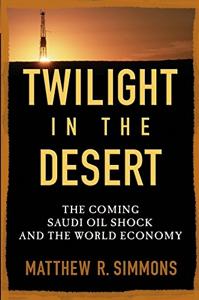
Want to learn the ideas in Twilight in the Desert better than ever? Read the world’s #1 book summary of Twilight in the Desert by Matthew R. Simmons here.
Read a brief 1-Page Summary or watch video summaries curated by our expert team. Note: this book guide is not affiliated with or endorsed by the publisher or author, and we always encourage you to purchase and read the full book.
Video Summaries of Twilight in the Desert
We’ve scoured the Internet for the very best videos on Twilight in the Desert, from high-quality videos summaries to interviews or commentary by Matthew R. Simmons.
1-Page Summary of Twilight in the Desert
The Oil Spigot
Saudi Arabia has been a major oil producer for decades, but its production is declining. That’s not good news because most of the country’s oil comes from six giant fields that have produced high volumes for years. To keep producing at current levels, the Saudis inject water into their reservoirs to maintain pressure in those fields.
The Middle East has the largest percentage of oil in the world. Saudi Arabia alone has about a quarter of all known petroleum reserves, which is staggering to think about. Perhaps this abundance explains why most observers never consider that there may be an end to Saudi’s oil supply—or what would happen if it did end.
Saudi Arabia’s world oil hegemony began on a specific day in history: January 15, 1902. That was the day when Abdul Aziz assembled a battalion of warriors to capture Riyadh. Before that, the Rashid Arab clan ruled Saudi Arabia with help from the Ottoman Empire. However, after he kicked them out and took control of other regions as well, he became king in 1926.
As Aziz made a successful push for power and territory, the Ikhwan were his most ardent supporters. However, after he gained power, he turned on them. He fought them for four years until they submitted to him. The influence of those zealots remains evident in Saudi Arabia’s strict religious controls today.
Saudi Arabia was poor before oil was discovered. The country only made money off of charging other Muslims for the pilgrimage to Mecca. However, after 1945, when Franklin Roosevelt and one of Saudi Arabia’s kings died, a lot changed. Five great oilfields were found in Saudi Arabia; oil production was about 840,000 barrels per day; and the country made $110 million every year from it.
Saud was replaced by his son, Faisal. Faisal grew ill and was dethroned by his brother, King Khalid. It was King Khalid who wielded the “oil sword” in October 1973 when he stunned Western economies with an OPEC oil embargo. During that time (the 1970s), Saudi Arabia had about six million people; now it has over 30 million people projected to reach 50 million in 2030.
Oil is critical to Saudi Arabia, accounting for 40% of its GDP and 95% of its export revenues. Currently, the kingdom faces six challenges:
Saudi Arabia needed to modernize its oil industry and diversify its economy in the 1970s. Its Basic Industries Corporation (SABIC) was created to develop a national petrochemical industry, which is now comparable to that of DuPont’s. However, more needs to be done.
The Saudi government currently needs to provide for its citizens. The need is greater because of the recent recession, which has forced many more people into poverty. In addition, debt is a problem in the country; it’s about $170 billion and continues to grow every year.
The unemployment rate in Saudi Arabia is between 15% and 25%. That’s a problem because many young Saudis are just entering the workforce. The government needs to create new industries that employ more people, so they can work instead of being unemployed.
Saudi Arabia, as a country with more citizens than Spain and less economic productivity, needs to increase its GDP substantially. In the near future, it will have as many citizens as Spain and still be unable to produce enough income for everyone.
Saudi Arabia needs to develop new industries. Experts say that it is unlikely the country will do this because it is highly dependent on oil profits.
The challenges that Saudi Arabia faces today are the same as those it has always faced.
The Squeaky Wheel
By 1978, industry insiders already knew that Saudi Arabia’s oil supply was limited. Aramco (Arabian American Oil Company) started studying ways to reverse the reduction in pressure at some of its most important fields. They decided to reduce production rates by 1.6 million barrels a day from 7.6 million daily to 6 million barrels per day, and “rest” the fields for several years until they were ready for a new round of drilling and pumping activity.






